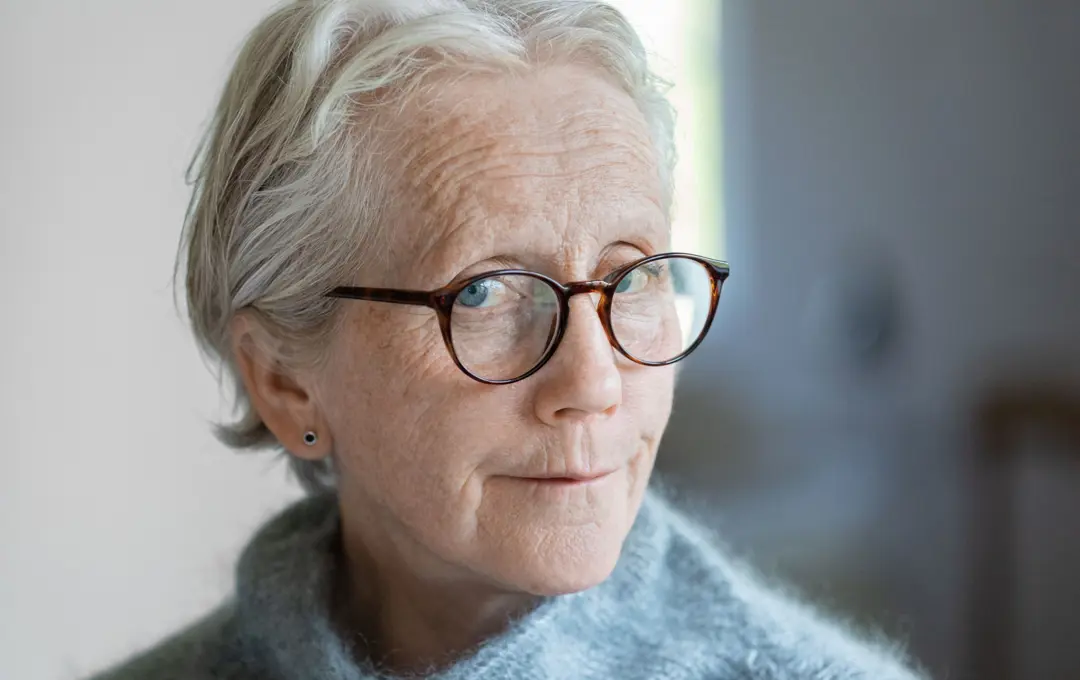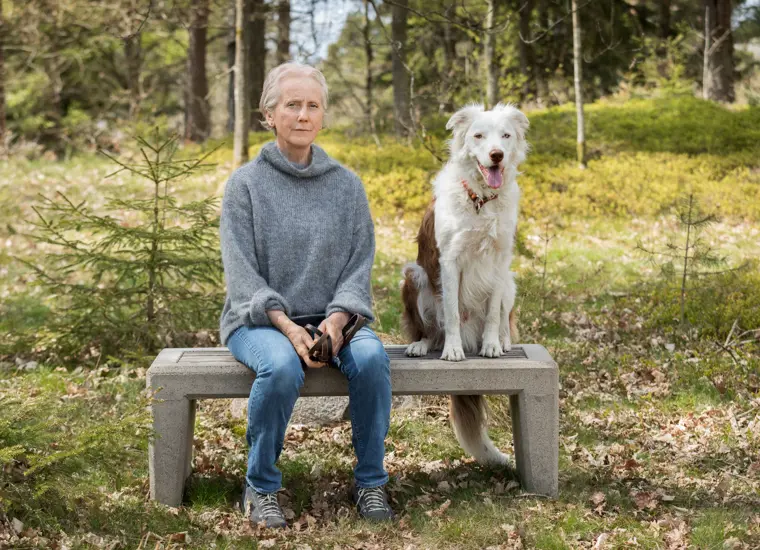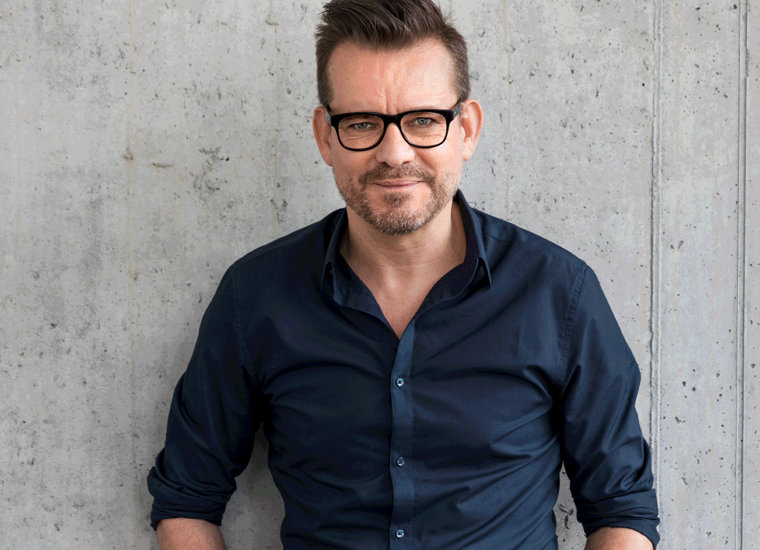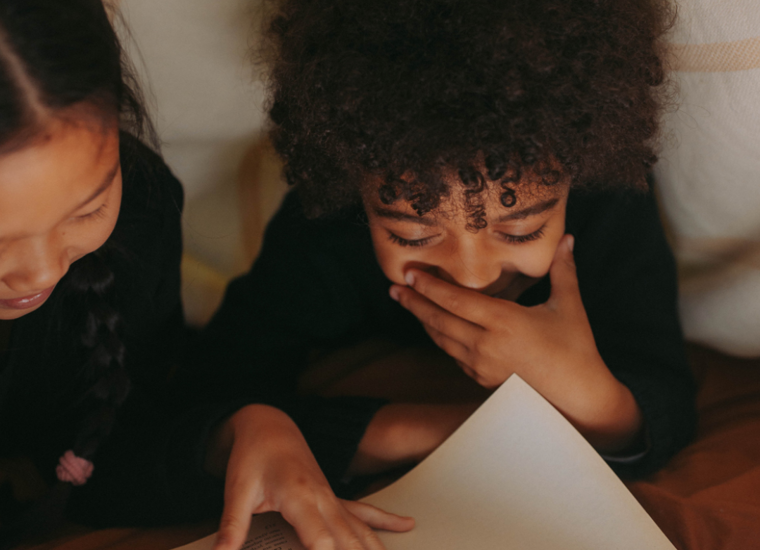Portrays moods and emotions
Eva Lindström is a Swedish picture book artist. She has published some 35 solo titles and has illustrated many books by other authors. Her work has been honored with multiple awards. She writes stories that shift between the everyday and the existential, combining shrewd humour with absurd mystery.
 Photo: Susanne Kronholm
Photo: Susanne KronholmQuick facts
The jury’s motivation
Eva Lindström’s enigmatic picture world is constantly transforming. Trees move abroad, dogs take on giant proportions and objects vanish, suddenly to reappear. With rapid brush strokes and dense colouration, Eva Lindström creates an ambiguous dialogue of text and image. The border between children, adults and animals is fluid. With great gravity and wild humour, they wrestle with the eternal questions: Who are we? Where are we going? Who took our hats?
Eva Lindström was born in 1952 and educated at Västerås Konstskola (the Västerås School of Art) and Konstfack (the University of Arts, Crafts, and Design) in Stockholm. Her extensive literary production for children began in the 1980s and has garnered many awards. In addition to authoring her own books, she has also illustrated books for other authors and has made three animated short films. Some of her books have also received film adaptations. In her latest picture book Ingenting är omöjligt för oss (Nothing Is Impossible for Us, 2021), the reader follows two small children and their dog as they land on another planet. The story conveys a sense of both isolation and community, as well pangs of loss for a missing father.
Eva Lindström has an altogether special profile among Swedish picture book artists. In both words and images, she portrays moods and emotions that may relate equally to big life questions and to the everyday events around which a child’s life revolves. She often takes her point of departure in the world of children’s experiences and logic. In a number of books, she captures the kinds of exciting dramas that play out among children. Her unusual narrative worlds, through which odd, lost, characters wander, possess enormous originality. Shrewd humour exists side by side with absurd mystery. The lines that separate children from adults are often vanishingly thin; the same applies to the lines between people and animals.
Eva Lindström’s immensely varied stories are capable of many interpretations and reward slow and thoughtful reading. Her uncompromising, boundary-crossing style has qualities that enable her to reach far beyond the intended target group for picture books.
The award ceremony took place on May 30, 2022, in Stockholm. The award was presented by H.R.H. Crown Princess Victoria of Sweden.
An uncompromising an boundary-crossing style
This text was written in 2022 by Elina Druker and Per Gustavsson.
Eva Lindström has an altogether special profile among Swedish picture book artists. Her unusual narrative worlds, through which odd, lost, characters wander, possess enormous originality. In both words and images, she portrays moods and emotions that may relate equally to big life questions and to the everyday events around which a child’s life revolves.
From her very first comic strips for Kvinnotidningen Q (Q Women’s Magazine) and her debut book, the comic album Tandem, created in 1985 with Gunna Grähs, Eva Lindström’s work displays the intersection of absurd comedy and rapid caricature that has become her hallmark. The comic album Först är det vinter (First, It’s Winter, 1990) is suffused with a sense of the instability of existence. It includes the story “Dom flyttar städerna” ("They’re Moving the Cities"), about a family who goes on holiday to a town in the south of Sweden. When they arrive, they see that the town has moved – to where, they don’t know. Disappointed, they return to their hometown, only to find a completely different city in its place.
Eva Lindström often takes her point of departure in the world of children’s experiences and logic. In a number of books, she captures the kinds of exciting dramas that play out among children. Shrewd humour exists side by side with absurd mystery. In Jag gillar Stig (I Like Stig, 1998) and Jag och Stig gräver en grop (Me and Stig Dig A Hole, 2000), she describes friendships, but also jealousy and a power struggle. Children’s games become imbued with unexpected meanings and can take on philosophical dimensions.
Eva Lindström frequently composes her illustrations using flattened perspective. She also often works within a small frame, placing her focus on physical comedy and body language, as in Limpan är sugen (Sizzles is Peckish, 1997), a picture book with no words that tells a story about a woman, a dog and a sausage. When the three meet, a dynamic interaction begins that suggests both friendship and community. Apan och jag (Monkey and Me, 2011), a similarly pared-down story, is told in rhyming verse and depicts a hide-and-seek-like game charged with both jealousy and longing.
But in Eva Lindström’s books, text and image do not always speak in unison. Her stories offer multiple interpretations and meanings, and perhaps also new ways of understanding a child’s feelings and relationships. Through the lens of the child’s imagination, the world appears in a different light. The naïveté of the child’s gaze also enables a certain scepticism toward grown-ups, as in Hit med våra mössor (Give Us Back Our Hats!, 2009), in which a birthday child’s father makes all the children’s hats disappear.
The lines that separate children from adults are often vanishingly thin; the same applies to the lines between people and animals. In the picture books Min vän Lage (My Friend Lage, 2001) and Vid bergens långa breda fot (By the Long Broad Foot of the Mountain, 2003), Lindström follows two different owls who are each looking for their place in the world. Lage is an owl who is famous from a nature program on TV. He moves to the city and tries his hand at a variety of jobs. For example, he starts a flying school for people. But will he live as an owl, or a human being? That’s the big question.
In Vid bergens långa breda fot, an owl named Janne is similarly struggling to find where he belongs. He has set himself up as a cook at a roadside snack bar in the middle of the woods. Standing over the grill is stressful and sweaty, and asking customers over and over what they want with their burgers – pickle or onion rings? – is monotonous. When a customer gets out his guitar and starts to sing a song about a man riding his horse across the prairie, Janne gets inspired to start making music and writing songs. He blocks out the world around him, enters a dream world and leaves the snack bar to its fate. There is wild humour in this tale, but also a strong sense of loneliness and isolation. Music streams out from the closed restaurant, but the text observes: “When you knock, no one opens the door.”
Eva Lindström rarely portrays the safety of home. Instead, she shows the world as ever changeable. An ordinary day can be interrupted by an extraordinary event, as in the illustrated chapter books about the two friends Mats and Roj (2002 and 2005) or the whodunit-like picture book Vilma och Mona spanar och smyger (Vilma and Mona Go Sneaking and Spying, 2004). Objects outlined in thin, vibrating lines are sprinkled across the pages in motley groups rich with tiny details.
Each item plays its own capricious role in an ongoing game in which new things are constantly being found, lost, and then found again. Anything is liable to disappear. “No one knows where you are, not even you,” say Vilma and Mona as they look for things that have moved. Lindström uses play and imagination to form the framework of a world in which familiar places and objects turn alien and elusive.
Sonja, Boris och tjuven (Sonja, Boris, and the Thief, 2007) is another picture book that develops into a kind of whodunit centred around the theme of things disappearing. But Eva Lindström references the mystery genre in her own way, parodying its conventions so that they take on overtones of the absurd.
The story takes place at a campground, where the friends have planned a peaceful vacation that never arrives. Instead, things start to disappear: first an air mattress, then a radio. The main plot involves a search for the guilty party. But there is a lot hiding under the surface, piquing the observer’s curiosity. More people move through the pictures than are mentioned in the text. Some lurk behind tree trunks; one is sunk deep in the pages of a newspaper. Meanwhile, all the accessories of a summer vacation – tennis racquets, croquet mallets, coffee cups – are strewn across the pages, seemingly at random.
The natural world is ever-present in Scandinavian children’s literature and in the world of picture books. Flowering meadows and deep, dark forests are familiar backdrops. Eva Lindström’s books often portray a more ambivalent relationship to nature. The picture book I skogen (In the Woods, 2008) features a forest that suddenly walks off, only to return later just as unexpectedly. It is a contemporary story that conveys apprehension in the face of threatening changes in the world around us. An atmosphere of myth or fairy tale hangs heavy over the woods. Everything here is animate. The trees and the birds can speak; the clouds race “crazily” across the sky. The depiction of the environment in Kom hem Laila (Come Home, Laila; 2018) also breathes mysticism and mystery. Here, the pared-down, poetic text and the colouristic landscapes in the pictures together form the distinctive foundation for the story.
Voyage and transfers of various kinds are also recurring motifs in Eva Lindström’s books. They frequently take on symbolic meaning and demonstrate how Lindström, in her later work, explores life’s big questions. In Olli och Mo (Olli and Mo, 2012), preparations are being made for an excursion that takes on unexpected dimensions. The journey begins at a café with green tea, sweet buns, and biscuits, but the fun trip is soon transformed into something altogether different. Despite the map that was packed, it is unclear where the characters are or where they are heading. This uncertainty – of arriving at new and unknown places, of finding the way back home – becomes the very motivation for their journey, as the characters travel over “fields and forests, steppes and mountains, rivers and deserts”.
Uncertainty is also a central theme in Bron (The Bridge, 2020), a story about a pig who is looking for a bridge and has gotten lost. He asks directions from a wolf and is invited for coffee at the wolves’ cabin. It is a subdued story in which a presentiment of danger resides, reinforced by looks, hints and tense, tentative dialogue. Just what is going on here? The choice of the animal characters is significant. The little pink pig, carrying a suitcase and dressed in tight green overalls, looks very small indeed next to the two tall wolves. They grin broadly, showing their white teeth, as they set out the coffee cups. Civilisation is placed in opposition to nature. The existence and meaning of the bridge remain a mystery. The book’s final line, delivered by an eagle, reads: “There is no bridge here”. How to interpret that answer is unclear, but it suggests that all communication has been definitively severed.
In Ingenting är omöjligt för oss (Nothing Is Impossible for Us, 2021), the reader follows two small children and their dog as they land on another planet. A stripped-down simplicity, thinly outlined figures, and increasing amounts of empty space between the characters combine to produce a distinctive atmosphere. The story conveys a sense of both isolation and community, as well pangs of loss for a missing father. But in its minimalism and lack of definition, the story also resists easy interpretation. It is a perfect illustration of how Eva Lindström makes artistic use of ambiguity. We never learn what the children have been through. Is the journey shown a symbolic one, a way of showing the grief of separation when a family suffers a painful departure? We can at least be certain that the children represent strength and indomitable optimism. Nothing is impossible for them.
Eva Lindström’s immensely varied stories are capable of many interpretations and reward slow and thoughtful reading. Her uncompromising, boundary-crossing style has qualities that enable her to reach far beyond the intended target group for picture books.
EVA LINDSTRÖM was born in 1952 and educated at Västerås Konstskola (the Västerås School of Art) and Konstfack (the University of Arts, Crafts, and Design) in Stockholm. Her extensive literary production for children began in the 1980s and has garnered many awards. In addition to authoring her own books, she has also illustrated books for other authors and has made three animated short films. Some of her books have also received film adaptations. The three films En fågeldag (A Bird Day, 2000), Min vän Lage (My Friend Lage, 2001) and Jag rymmer! (I’m Running Away, 2006) which all feature animal characters in the main roles, form the film trilogy Djurvännerna (Animal Friends).
It’s important for everyone – not just adults – to be able to access worlds we might never encounter any other way, to be exposed to ideas that make life seem bigger, ideas that stimulate our imaginations.

"I get inspiration from everything that comes into my life"
When did Eva Lindström know that she wanted to be a writer and illustrator of picture books? What was she like as a child and does she always have a book going in her head?
Read our interview with the 2022 laureateEva Lindström in conversation with journalist Yukiko Duke. Filmed at Södra Teatern in Stockholm, Tuesday 24 May, 2022.

Discover our laureates
The Astrid Lindgren Memorial Award is awarded to authors, illustrators and narrators, but also to people or organizations that work to promote reading.
Find out more about the laureates
Children have the right to great stories
To lose yourself in a story is to find yourself in the grip of an irresistible power. A power that provokes thought, unlocks language and allows the imagination to roam free. The Astrid Lindgren Memorial Award was created in 2002 by the Swedish government to promote every child’s right to great stories.
Find out more about the award